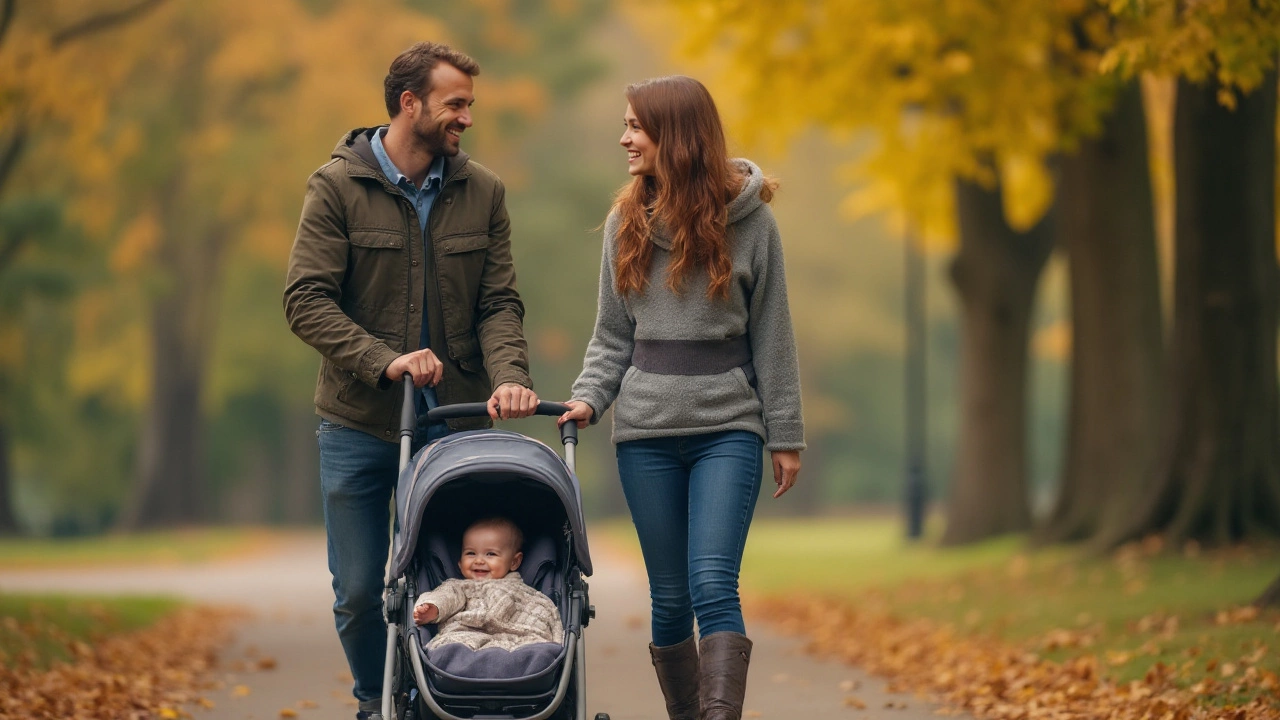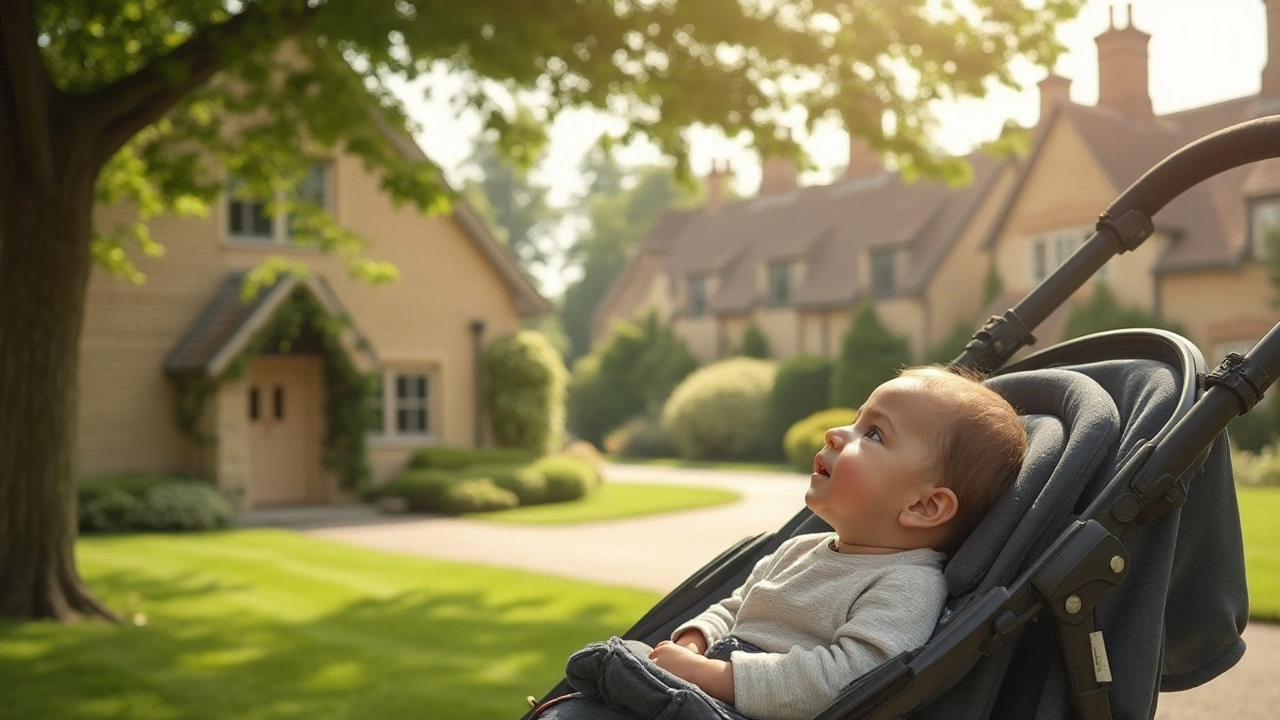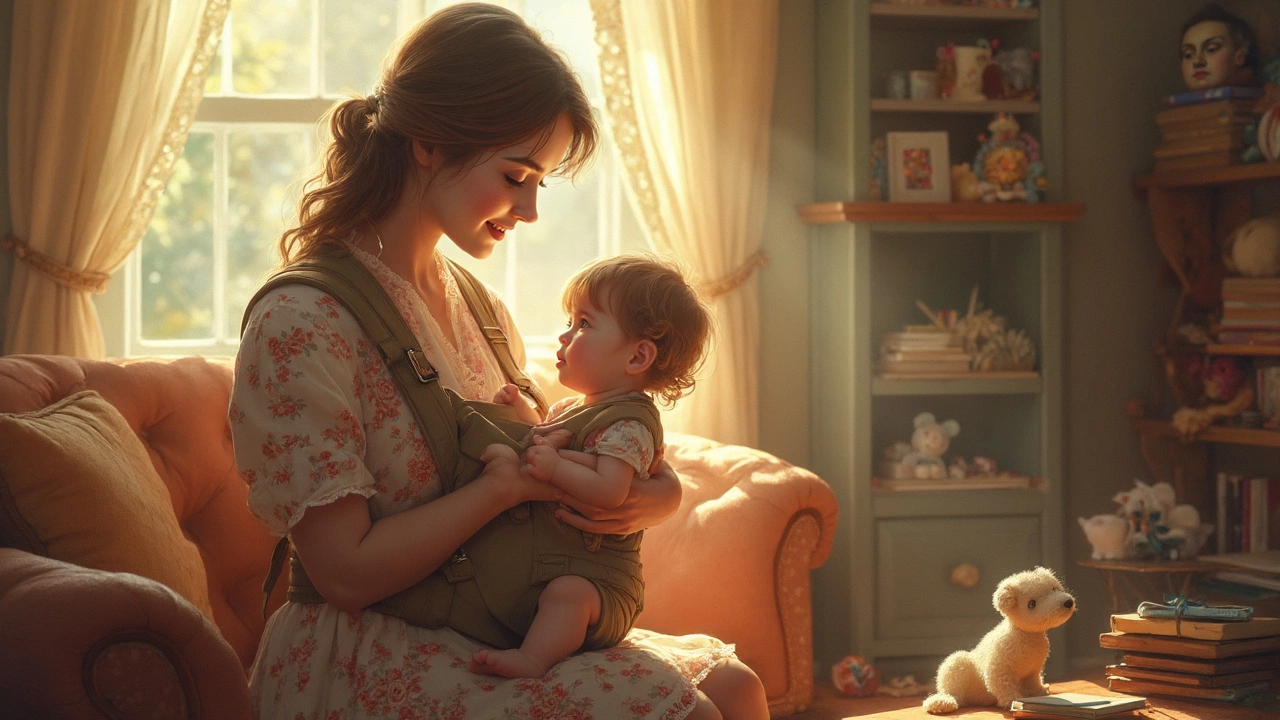When Can Your Newborn Safely Venture Out in a Stroller?

Taking your newborn out for their first stroller ride can be both exciting and a bit nerve-wracking. The key is making sure your little one is ready and that you have the right gear. Babies are all different, but there are ways to make this experience safe and enjoyable.
Knowing which stroller is suitable for newborns is essential, as not all are designed for their delicate state. Added to this, understanding your baby's physical development, like neck strength, can help you decide when it's safe to start strolling. Let's explore how to make your baby's first outings as secure and comfortable as possible.
- Understanding Newborn and Infant Stroller Types
- Evaluating Newborn Stroller Safety Features
- Recognizing Your Baby's Physical Readiness
- Considering Seasonal and Climate Factors
- Expert Tips for Safe and Happy Strolling
Understanding Newborn and Infant Stroller Types
Choosing the right stroller for your newborn is a decision that's layered with considerations about safety, comfort, and practicality. For the uninitiated, strollers specifically designed for newborns and infants can vary widely, each type catering to different needs and lifestyles. From lightweight travel systems to luxurious bassinet options, the array is both dazzling and daunting. Among the popular choices, some parents opt for a travel system, which typically includes a stroller and a car seat that seamlessly clicks into place. This design is especially helpful for parents on the go, allowing them to transition smoothly from car to stroller without disturbing the baby.
Bassinet strollers, on the other hand, are adored for their traditional pram-like design, offering the baby a flat, enclosed place to lie down. This feature is critical as newborns require ample support and space to lie on their backs comfortably, complying with pediatric advice from sources like the American Academy of Pediatrics. Bassinets often come with added features like adjustable canopies and storage spaces, making them a versatile choice for many parents. It is vital to ensure that whichever option you choose has secure harness systems and meets the latest safety standards.
Parents may also encounter convertible strollers. These adaptable wonders start with accommodating infants and, with a quick switch-up, grow with the child. Many of these models allow you to add accessories like a second seat or a glider board for an older sibling, making them advantageous for expanding families. An important stroller advice is to consider your lifestyle. If you often find yourself on quick errands or travel frequently, a compact, foldable design might be your best bet. They are treasured for their easy-fold mechanics and lightweight structure but remember that durability and comfort should not be sacrificed for portability.
"It's not just about finding a stroller that suits your immediate needs, but rather one that adapts as your child grows," remarks Jennifer LaRue Huget for The Washington Post, emphasizing the importance of long-term thinking in such purchases.
Some strollers also feature all-terrain wheels, designed for parents who enjoy outdoor strolls in parks or rougher paths. The robust tires ensure smooth travels over any surface, which can be crucial for keeping your baby comfortable and undisturbed during naptime excursions.
To sum up, understanding the different types of strollers available helps in making an informed decision, and it's wise to test out different models in-store when possible. This way, when you choose the right baby stroller, it's not just another purchase, but an investment in quality time spent safely and comfortably with your newborn. Such preparation lays the groundwork for memorable outings, as both you and your baby explore the world together one stroll at a time.
Evaluating Newborn Stroller Safety Features
When it comes to choosing a stroller for your newborn, safety is understandably a top priority. While many strollers are marketed towards infants and babies, not all are suitable from birth. One of the first things to consider is whether the stroller offers a fully reclining seat, which is crucial for newborns who need to lie flat to support their still-developing neck and spine. Strollers that can accommodate a compatible car seat or a bassinet attachment offer the versatility of keeping your baby in a safe and ergonomic position while on the move.
The harness system is another important safety feature. Strollers should be equipped with a five-point harness—a standard safety feature that secures the baby at the shoulders, waist, and between the legs. This type of harness prevents your infant from slipping or climbing out, offering peace of mind even on the bumpiest terrain. Check that the harness is easy to adjust, providing a snug fit as your baby grows.
Another feature to look for is a sturdy braking system. A reliable brake will lock the stroller into position, ensuring it doesn't roll away when you're distracted or on uneven surfaces. Consider parking brakes that are shoe-friendly, avoiding the need to bend down—a crucial convenience for parents juggling multiple tasks.
Additionally, the stroller's frame should be stable and not easily tipped over. Strollers with a wide base tend to offer better stability. Look for ones made from high-quality materials, such as aluminum or reinforced plastics, which are both lightweight yet durable. Many strollers now pass rigorous safety standards, and it's wise to check for certifications like that from the Juvenile Products Manufacturers Association (JPMA) to ensure the model fulfills key safety criteria.
According to Carole Kramer Arsenault, a registered nurse and author, "Safety features aren't just bonuses. They're necessities. A stroller isn't a stroller without them."
Examining the quality of the axle and tire system can also greatly affect stability and safety. Large, well-constructed tires often allow for smoother rides and greater control. Strollers that feature all-wheel suspension will provide a smoother experience for the baby, absorbing some of the shocks from uneven surfaces.
Weather protection is an element often overlooked in safety considerations. Ensure the stroller has an adjustable canopy that can protect your baby from direct sunlight, wind, or rain. Ventilation is equally crucial, so look for canopies that include mesh panels to maintain airflow, reducing the risk of overheating during warm weather.
Lastly, consider the stroller's weight and ease of folding, particularly if you'll be traveling frequently. Lighter models are easier to lift and load into a car, but that shouldn't compromise safety. Many strollers offer a one-hand fold which can be a lifesaver when managing a newborn and their gear. By reviewing and evaluating these safety features, parents can ensure a comfortable and secure strolling experience for their little one, giving them the confidence needed for those early adventures.

Recognizing Your Baby's Physical Readiness
A paramount aspect of deciding when to take your newborn in a baby stroller involves understanding their physical development. The very first months, your baby is still growing into their new life outside the womb. One crucial area of development is neck strength. Most babies start to gain enough neck control to hold their head up by around three to four months of age, but each child develops at their own pace. It's essential to ensure your baby can comfortably sit in a reclining position, whether in a stroller with an attached infant car seat or a fully reclining seat designed for newborns. When considering a stroller ride, your baby's ability to maintain some head control can significantly influence safety and comfort during the journey. Observing your baby's cues and milestones can be a great guide in gauging their physical readiness.
Aside from neck strength, another factor is understanding your newborn's general health and comfort level. For infants less than six months old, choosing a stroller that provides full back and head support is often necessary. Many parents find that a travel system stroller, which includes a car seat that easily attaches to the base, is practical until the baby is ready to sit in the stroller seat on its own. This integrated approach ensures that the newborn's spine remains in a safe, flat position. Pediatricians often suggest that if your baby appears uncomfortable or fussy when placed in the stroller, they might not be ready, highlighting the importance of not rushing into using the stroller before it feels right for your child. Paying attention to how your infant interacts with the environment from the stroller can also offer insights into their comfort levels.
Assessing physical readiness also involves practical considerations like the baby’s most awake times. It's ideal to take them strolling when they are well-rested and not too hungry. A well-fed, cozy infant is far likelier to enjoy the smooth motion of a stroller ride. Moreover, in cases where your baby may be approaching developmental stages like teething, their comfort and mood can vary from day to day. At such times, babies may become more sensitive, which can affect their reaction to new experiences like stroller rides. Taking account of these factors is vital to ensure your infant's safety and happiness during outings in a newborn stroller.
The American Academy of Pediatrics offers guidance suggesting that parents should utilize stroller models with good suspension systems and large canopies. This ensures that the baby is protected from excessive sun exposure while enjoying a smooth, gentle ride. Additionally, they recommend regular breaks, allowing the baby to stretch to avoid stiffness or discomfort from staying in a single position too long. Incorporating these elements into stroller use can enhance not only the baby’s physical readiness but also their overall experience.
"Parents should ensure that strollers support their baby's head, neck, and spine, particularly in the first few months," advises Dr. John Simms, a noted pediatrician. "Checking each manufacturer's age recommendations can guide the selection process significantly."
Considering Seasonal and Climate Factors
When it comes to taking your newborn out in a baby stroller, the season and climate can significantly influence your choices. It's not just about keeping your baby comfortable but ensuring they are safe from extreme weather conditions, whether it be the biting cold or sweltering heat. During winter, infants are particularly vulnerable to hypothermia because they lose body heat rapidly. Dressing your baby in layers and using footmuffs or stroller blankets can help maintain the warmth. Additionally, be mindful of ice or snow that could make paths slippery, risking falls or stroller accidents.
In contrast, the summer sun poses its own set of challenges. Babies have delicate skin that can easily sunburn, so using a stroller with a large canopy is advisable to shield them from harmful UV rays. Ventilation is key to keeping your little one cool, so choosing a stroller with mesh panels might be a smart choice. Hydration is also crucial, and even though infants primarily get their fluids from milk, it's essential to ensure they aren't overheating.
"It's important to remember that infants cannot regulate their body temperature as effectively as adults," says pediatric health expert Dr. Lucy Wirth. "Always check their neck or back to gauge if they are too hot or cold, rather than their hands, which may naturally feel cooler."
Different regions also present different environmental factors to consider. If you live in an area with high humidity, ensure the stroller is made of breathable materials to prevent rashes and discomfort. Conversely, in a dry climate, keeping your baby moisturized can avoid their skin becoming chapped. Also, remember that back in the stroller, when the weather shifts quickly, it's handy to have a rain cover or a windscreen attachment so you're prepared for unexpected showers or gusts.
Here's a quick list of items to prepare for your stroller outings across the seasons:
- For winter: Layered clothing, stroller footmuff, weather cover.
- For summer: Stroller fan, sunshade canopy, breathable fabrics.
- For rainy weather: Rain cover, light waterproof clothing, spare clothes.
- For windy conditions: Windscreen, secure blanket or shawl.
As you plan outings, consider the time of day too. Early morning or late afternoon are usually the calmest, temperature-wise, and provide a more serene experience for both you and your baby. Always remember, a little preparation goes a long way in making those early stroller experiences enjoyable and safe.

Expert Tips for Safe and Happy Strolling
Heading out with your newborn snug in a baby stroller is a wonderful way to introduce them to the world. The fresh air is good for both the baby and the parents. To ensure that these outings are as safe and enjoyable as possible, there are several expert-backed tips to consider. One of the most important aspects is ensuring that the stroller you choose has effective safety harnesses. These should secure your newborn comfortably without being too tight, allowing for movement and flexibility while keeping them safely nestled in place. Remember, infants have delicate necks and heads, so selecting a stroller with adequate cushioning and head support is crucial.
Parents should also pay attention to the weather conditions. On sunny days, using a stroller with a reliable canopy provides shade, protecting the baby's sensitive skin from harmful UV rays. For colder days, it's advisable to dress the child warmly, but not too warmly, and use a footmuff or blanket designed for strollers to keep them cozy. Pediatricians often recommend checking on your baby frequently during stroller rides to ensure they are comfortable, especially if they tend to fall asleep.
Beyond the basic gear considerations, making those initial strolls educational and stimulating can make a difference. Gradual exposure to different surroundings can help in the developmental growth of a newborn, stimulating their senses and curiosity. When possible, choosing a route with varied scenery, such as a park with trees, birds, and flowers, can be quite enriching for your baby. Also, remember to keep the stroller at a smooth pace without sudden stops, ensuring it’s a calm and smooth ride.
As Jessica Bauer, a renowned pediatrician notes, "Keeping your baby engaged during these outings is essential. Soft talk and calm music can enhance a child’s sensory experience, and it’s a good time for parents to connect deeply with their little one."
Lastly, remember that stroller maintenance is just as important as the ride itself. Check the wheels regularly for wear and tear, and ensure all the moving joints are functioning properly to avoid any mishaps during your trips. Make sure the brakes are in perfect condition, as this adds an extra layer of safety during walks, especially on uneven or sloping terrains. These simple checks can contribute significantly to your baby’s safe strolling experiences, making every outing a delightful, stress-free journey for both of you.


